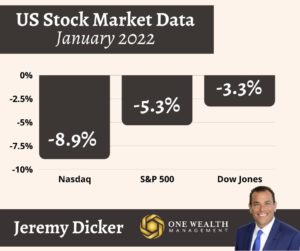
Stocks
In January 2022, the stock market saw some of its biggest declines in almost two years and even brief movement into correction territory.
For the month:
The S&P 500 was down 5.3%.
Dow Jones Industrial Average was down 3.3%.
Nasdaq Composite down 8.9%.

That was the S&P 500’s worst month since March of 2020 when it saw a 12.5% decline. It was also Nasdaq’s worst month since March 20202.
However, while starting the month with a swoon, stocks rebounded in the final days and continued a healthy recovery in February.
Index prices are still more than 90% recovered from their 2020 lows.
Biggest winners and losers
With equities receding in large part throughout January, investors looked for safe ground by embracing core commodities once again. For the month, WTI crude oil was up 17.12%, gasoline up 14.6%, and coffee prices rose by 4%.
For that same reason, the biggest losers were cryptocurrencies in January, with Ethereum dropping 26.7%, Dogecoin down 17.3%, and Bitcoin falling 17%.
Gold (-1.8%) and the dollar (+0.9%) were on different sides of the ledger, although stable.
Inflation
While incessant inflation has consumed the news – and affected our wallets – throughout 2021, there are subtle signs that price growth may have peaked and is leveling off.
Of course, inflation reached a 39-year high (since June 1982) in December 2021, and the Bureau of Labor Statistics reported that prices ended the year a full 7% higher.
However, consumer prices rose only 0.5% in December.
Likewise, the Core Price Index (CPI) rose by only 0.6% in December and 5.5% for the year. The CPI excludes energy and food prices, of course, and that’s where a large portion of past price gains have occurred.
Interestingly, skyrocketing prices for both used and new automobiles are leading all metrics, thanks to global semiconductor supply shortages. But energy prices actually dropped in December by 0.4%.
Other categories saw only marginal price increases, signaling a slowing of inflation, such as apparel (only +1.7% in December) and rents (+0.4%).
Another telltale sign that inflation may be rounding into shape is December’s survey of consumer inflation expectations. The metric, based on a survey conducted by the Federal Reserve Bank of New York, dropped for the first time in 14 months (albeit by a nominal amount). Three-year expectations for inflation registered a robust 30 basis points lower than their highs in October 2021.
The Fed is also aiming all of their canons at inflation and will almost certainly start their increase of the federal funds rate three or even four times in 2022, starting in March.
The Fed
When the Federal Reserve policymakers meet March 15-16, they’ll decide to raise the Federal Funds rate at least a quarter-point in a near-unanimous desire to start stripping away pandemic-era stimulus and policies.
Fed Chairmen Jerome Powell is on record as saying the central bankers are “of a mind” to raise rates at their March meeting.
That would be the first rate increase in more than three years, and the markets are pricing in at least give quarter-point interest rate increases throughout 2022.
What is missing from Powell and Fed Central Bankers is a clear policy direction for how they will taper their massive bond buying program.
With inflation at a 40-year high, the job market in flux, and Omicron disrupting our economy, they will keep trying to read the tea leaves, focused on reducing inflation but remaining resilient for what’s next as we shift to a post-pandemic economy.
Expect the Fed’s opinion to remain fluid based on jobs numbers (which came in far more positive than expected, and other data-driven factors.
GDP growth
After a solid growth spurt in 2021, analysts expect GDP growth to slow in the first three months of 2022, a notable change from Q4 2021’s 6.9% growth rate.
HIS Markit, one of Wall Street’s most trusted forecasters, feels that GDP will expand by less than 2% annually from January to March. Others, like Atlanta Federal Reserve’s GDPNow tracker, see little if any GDP growth for Q1.
A tight labor market, the fallout of inflation, slowing consumer spending and business production, and, of course, Omicron concerns all factor into the anticipated GDP stagnation.
Employment
Bucking expectations from Wall Street, January’s job data came in much more robust than anticipated.
According to the highly anticipated Bureau of Labor Statistic report (released at 8:30 am EST of Friday, February 4th), December’s non-farm payrolls added 467,000 jobs.
Those are notable numbers considering January saw the peak of Omicron disruptions and a seasonal post-holiday slowdown, coming in approximately 125,000 more than expected.
Perhaps, we could have expected as such since December’s job numbers were revised far higher, too, from the 199,000 originally reported to a healthy 510,000.
Despite Omicron, job growth in leisure and hospitality remained positive in January with 151,000 additions, and retail jobs grew by 60,000 throughout the month.
However, the unemployment rate did creep up to 4% for January versus the forecast of 3.9%.
Notable quote
“There is a real danger of the Fed overdoing it on the monetary tightening front, just as the economy is naturally slowing down, fiscal stimulus is unwinding, and financial conditions are about to tighten.”
– Scott Anderson, chief economist at Bank of the West
Sources:


